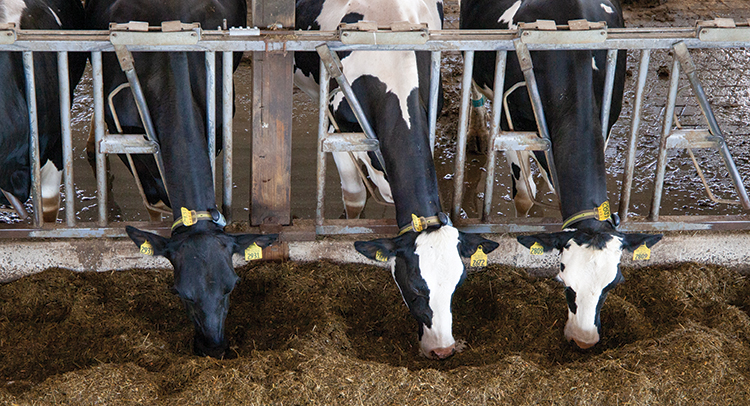
Imagine sitting down at your favorite supper club and looking at the menu with friends and family. If you’re not familiar with a supper club, picture a restaurant similar to a steakhouse, except that a waiter or waitress brings your party a menu in a bar area prior to seating your group at the table. The order is placed ahead of being seated, and your party is only brought to the table when the food is nearly ready.
I share this anecdote because one aspect of the experience is that the salad comes out prior to the entrees. Salad and greens are an important part of a meal because the fibrous food provides some ballast; salad is the least and slowest digested food consumed, which helps avoid overeating.
Think of fiber in a dairy or beef diet in the same way. Fiber provides bulk to diets — it’s the most important factor to account for when evaluating forages and developing dairy or beef diets. Despite the many different discussions around fiber digestibility and undigestible fiber, total fiber content is always my starting point in evaluating forage quality.
Like your laundry
Cornell University’s Peter Van Soest and others defined fiber in ruminant nutrition as the neutral detergent insoluble residue after a laboratory assay that is similar to a laundry rinse cycle with clothing. Forage analysis reports list fiber as aNDF, which depicts neutral detergent fiber. The “a” stands for amylase. Amylase is important to break down starch in the forage sample and wash it out so that only neutral insoluble fiber remains.
Recognizing that fiber is the insoluble residue left after an hour long, boiling laundry detergent rinse, you can speculate why it is the least digestible nutrient, and more fiber detracts from your forage energy value per pound or ton.
Dairy nutrition experts have found that fiber digestibility is a critical component to understand when formulating diets for optimum feed conversion efficiency. Fiber digestion is confusing, but the nutrition revelation comes due to the fact that total tract fiber digestion can range from as low as 30% to greater than 70%. Percentages can be confusing, so think of this fiber fact this way: For every 10 pounds of fiber consumed, the poorest performing diets provide just over 3 pounds of digestible fiber and the best diets can achieve upward of 7 pounds!
Each pound of digestible fiber acts just like starch or sugar in providing enough energy for about 3 to 4 pounds of milk per cow. However, fiber is always less digestible than the other nutrients, including starch, sugar, protein, and fat. So, while fiber exhibits a wide range in digestibility due to seed genetics, growing conditions, and agronomic management, fiber is always the first limiting factor in diet energy. This leads us back to the main point — don’t forget about the total fiber in your forage.
Have fiber goals
Total fiber content in corn silage, hay, and haylage can range from as low as 30% to greater than 70%, which are the same percentages as described above for fiber digestibility. However, in this case the fiber percentages represent the fiber amount relative to the total forage dry matter. At 30% aNDF, this can be thought of as 3 pounds of fiber in 10 pounds of hay. With this low-fiber, high-quality forage, the remaining 70% of the forage is composed of more digestible and valuable protein, starch, sugar, fat, or other nutrients.
At 70% fiber, or 7 pounds of fiber out of 10 pounds total hay, the energetic value for this forage is severely limited because 30% or less of the forage is higher energy nutrients. The goal for high-quality forage is typically to achieve less than 40% aNDF for corn silage or alfalfa hay/haylage. With grass hays or silages, the goal stretches up to 45% to 50%, recognizing that grasses typically contain less protein than alfalfa but have exceptional fiber digestibility when harvested at an immature stage.
Monitor fiber levels
The way to improve haycrop forage quality is to monitor crop maturity throughout the season. Fiber increases with maturity as the stems elongate and make up a larger proportion of the plant. Do not rely on the calendar for cutting decisions; there is no consistent cutting interval that will routinely yield less than 40% fiber. Work with your agronomist and nutritionist to check fiber levels in the growing hay crop and recognize the standing crop fiber value will likely rise by around 2% to 4% during harvest and storage due to leaf and storage losses.
With corn silage, sorghum, or other standing cereal crops chopped for silage, seed genetics and harvest maturity also influence the fiber level. With these crops, the fiber is diluted out by grain, so more grain equates to less fiber. Generally speaking, more grain equates to more energy. However, fiber digestibility lessens and grain hardness intensifies as starch is laid down and the kernel maturity moves past 1/2 milkline and toward black layer.
Work to balance the correct harvest timing and achieve less than 40% fiber but also optimal maturity for ensiling and carbohydrate digestibility. Just like the salad coming first at the supper club, your farm will benefit by recognizing the fiber in forage is the number one determinant of quality.
This article appeared in the January 2021 issue of Hay & Forage Grower on page 18.
Not a subscriber? Click to get the print magazine

